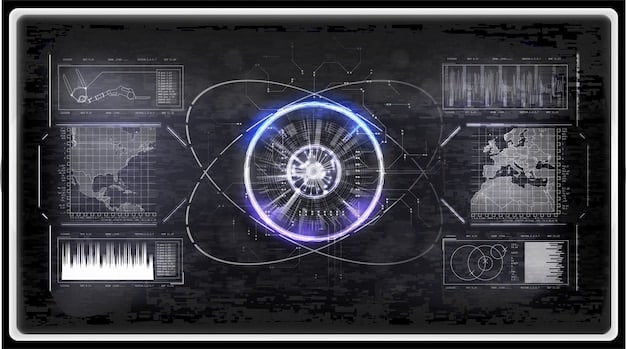Defense Industry Export Controls: Navigating ITAR & EAR in 2025

Defense Industry Export Controls: Navigating ITAR and EAR Regulations in 2025 requires a deep understanding of the International Traffic in Arms Regulations (ITAR) and the Export Administration Regulations (EAR). These regulations govern the export of defense-related items and technologies, and compliance is critical for companies in the defense sector.
Navigating the complex landscape of Defense Industry Export Controls: Navigating ITAR and EAR Regulations in 2025 is a critical challenge for companies operating in the defense sector. Understanding and complying with the International Traffic in Arms Regulations (ITAR) and the Export Administration Regulations (EAR) is not just a matter of legal compliance, but also essential for maintaining national security and strategic competitiveness.
This guide explores the key aspects of ITAR and EAR, providing insights and strategies to help defense industry players successfully navigate the regulatory environment anticipated in 2025. We will examine the evolving challenges, compliance best practices, and technological solutions enabling effective Defense Industry Export Controls: Navigating ITAR and EAR Regulations in 2025.
Understanding ITAR and EAR: Core Regulations in 2025
The International Traffic in Arms Regulations (ITAR) and the Export Administration Regulations (EAR) are the cornerstones of Defense Industry Export Controls: Navigating ITAR and EAR Regulations in 2025. These regulations dictate how defense-related items, technologies, and services can be exported from the United States.
Key Differences Between ITAR and EAR
ITAR primarily controls the export of items and services specifically designed or modified for military applications, covering a wide range of defense articles and related technical data. EAR, on the other hand, regulates the export of dual-use items that have both commercial and military applications.
- ITAR focuses on items and services on the United States Munitions List (USML).
- EAR covers items on the Commerce Control List (CCL), including those with dual-use capabilities.
- Compliance with both ITAR and EAR requires understanding the specific classifications and licensing requirements for each item.
In essence, ITAR is more stringent and specific to military items, while EAR has a broader scope, encompassing items that could be used for both civilian and military purposes. Keeping abreast of these distinctions is crucial for Defense Industry Export Controls: Navigating ITAR and EAR Regulations in 2025.
Navigating these regulations effectively involves not only understanding the classifications but also staying informed about any updates or amendments. The penalties for non-compliance can be severe, ranging from hefty fines to imprisonment, emphasizing the need for robust compliance programs within the defense industry. To ensure full conformance to Defense Industry Export Controls: Navigating ITAR and EAR Regulations in 2025, consistent monitoring and training are essential.

Evolving Challenges in Defense Export Compliance
As we approach 2025, several evolving challenges are reshaping the landscape of defense export compliance. Technological advancements, geopolitical shifts, and regulatory changes are creating new complexities that defense companies must address to ensure effective Defense Industry Export Controls: Navigating ITAR and EAR Regulations in 2025.
The Impact of Emerging Technologies
Emerging technologies such as artificial intelligence (AI), cybersecurity, and advanced materials are presenting unique challenges to export control. These technologies often have dual-use applications, making it difficult to determine whether their export should be restricted under ITAR or EAR.
The ambiguity surrounding the classification of these technologies requires companies to implement robust due diligence processes and seek expert guidance to ensure compliance. Furthermore, the rapid pace of technological innovation means that export control regulations must continually adapt to keep pace, adding another layer of complexity to the process of Defense Industry Export Controls: Navigating ITAR and EAR Regulations in 2025.
Geopolitical and Regulatory Shifts
Geopolitical instability and shifts in international relations can significantly impact defense export controls. Changes in alliances, trade policies, and international agreements can lead to new restrictions or requirements for defense exports.
Regularly monitoring geopolitical developments and understanding their potential implications for export controls is essential for companies operating in the global defense market. Additionally, regulatory authorities such as the U.S. Department of State and the Department of Commerce periodically update ITAR and EAR, requiring companies to stay informed about these changes and adapt their compliance programs accordingly, ensuring their Defense Industry Export Controls: Navigating ITAR and EAR Regulations in 2025 remain effective.
In response to these challenges, defense companies are increasingly leveraging technology to streamline their compliance processes. Export control software, automated screening tools, and data analytics platforms are helping companies manage the complexities of ITAR and EAR more efficiently and effectively. By embracing these technological solutions, companies can strengthen their Defense Industry Export Controls: Navigating ITAR and EAR Regulations in 2025 and reduce the risk of non-compliance.
Best Practices for ITAR and EAR Compliance in 2025
To effectively navigate the complexities of Defense Industry Export Controls: Navigating ITAR and EAR Regulations in 2025, defense companies must adopt comprehensive compliance programs. These programs should encompass a range of best practices, from conducting thorough risk assessments to implementing robust training programs.
Conducting Risk Assessments
A critical first step in ensuring ITAR and EAR compliance is to conduct a comprehensive risk assessment. This assessment should identify potential vulnerabilities in the company’s export control processes and evaluate the likelihood and impact of different types of compliance breaches.
By understanding these risks, companies can prioritize their compliance efforts and allocate resources effectively. Risk assessments should be conducted regularly and updated to reflect changes in the company’s operations, the regulatory environment, and geopolitical factors related to Defense Industry Export Controls: Navigating ITAR and EAR Regulations in 2025.
Implementing Robust Training Programs
Training is another essential element of an effective ITAR and EAR compliance program. All employees involved in the export process, from sales and marketing to engineering and logistics, should receive regular training on export control requirements and best practices.
Training programs should be tailored to the specific roles and responsibilities of each employee and should cover topics such as:
- ITAR and EAR regulations
- Item classification
- Licensing requirements
- Recordkeeping
Regular training ensures that employees understand their obligations and are equipped to identify and address potential compliance issues. This proactive approach dramatically bolsters Defense Industry Export Controls: Navigating ITAR and EAR Regulations in 2025.

Leveraging Technology for Efficient Export Management
In the digital age, technology plays a pivotal role in streamlining export management processes. Implementing the right technological solutions can significantly enhance efficiency, accuracy, and compliance in navigating ITAR and EAR regulations in 2025.
Export Control Software
Export control software is designed to automate various aspects of the export compliance process, from item classification and license determination to export screening and recordkeeping. These solutions can integrate with existing enterprise systems, providing a centralized platform for managing all export-related activities.
Automated Screening Tools
Automated screening tools help companies identify potential red flags in export transactions, such as restricted parties, embargoed destinations, and suspicious end-uses. These tools can screen customer orders against global watch lists and automatically flag transactions that require further review.
The automated systems facilitate thorough Defense Industry Export Controls: Navigating ITAR and EAR Regulations in 2025.
By leveraging these technological solutions, defense companies can significantly improve the efficiency and effectiveness of their export compliance programs. Automation reduces the risk of human error, streamlines workflows, and allows compliance teams to focus on higher-value tasks. Overall, technology is a key enabler for successful Defense Industry Export Controls: Navigating ITAR and EAR Regulations in 2025.
Preparing for Future Changes in Export Regulations
The landscape of defense export controls is constantly evolving, and companies must remain vigilant and proactive in preparing for future changes. This includes staying informed about regulatory updates, participating in industry forums, and engaging with government agencies.
Staying Informed About Regulatory Updates
The U.S. Department of State and the Department of Commerce regularly issue updates to ITAR and EAR, reflecting changes in national security priorities, trade policies, and international agreements. Companies should closely monitor these updates and assess their potential impact on their export operations.
Subscribing to regulatory alerts, attending industry conferences, and consulting with legal experts can help companies stay abreast of the latest developments and effectively manage Defense Industry Export Controls: Navigating ITAR and EAR Regulations in 2025.
Engaging with Government Agencies
Building relationships with government agencies such as the Directorate of Defense Trade Controls (DDTC) and the Bureau of Industry and Security (BIS) can provide valuable insights into export control requirements and best practices.
Engaging with these agencies through consultations, advisory opinions, and voluntary disclosures can help companies navigate complex regulatory issues and demonstrate their commitment to compliance. Being communicative and forward-thinking strengthens Defense Industry Export Controls: Navigating ITAR and EAR Regulations in 2025.
| Key Point | Brief Description |
|---|---|
| 🛡️ ITAR & EAR | Core regulations governing defense exports. |
| 🌐 Evolving Challenges | New tech and geopolitical shifts complicate compliance. |
| ✅ Best Practices | Risk assessments and training programs are essential. |
| 🚀 Tech Solutions | Automated software improves export management. |
Frequently Asked Questions
ITAR controls military-specific items on the USML, while EAR regulates dual-use items on the CCL. ITAR is stricter, focusing on defense articles; EAR covers items with both commercial and military applications relevant to Defense Industry Export Controls: Navigating ITAR and EAR Regulations in 2025.
Risk assessments should be conducted regularly, at least annually, or more frequently if there are significant changes in the company’s operations, the regulatory environment, or geopolitical factors. Staying up-to-date enhances compliance.
Technology plays a critical role by automating compliance processes, screening transactions, and improving recordkeeping related to Defense Industry Export Controls: Navigating ITAR and EAR Regulations in 2025. Export control software and automated screening tools help reduce errors.
The penalties for non-compliance can be severe, including hefty fines, loss of export privileges, and even imprisonment. Strict adherence is essential to avoid these serious repercussions and maintain operational integrity.
Companies can monitor updates from the DDTC and BIS, attend industry conferences, subscribe to regulatory alerts, and consult with legal experts. Proactive monitoring ensures readiness and successful navigation of export regulations.
Conclusion
Navigating Defense Industry Export Controls: Navigating ITAR and EAR Regulations in 2025 requires a proactive and comprehensive approach. By understanding the core regulations, addressing evolving challenges, and implementing best practices, defense companies can effectively manage export compliance and mitigate risks.
Leveraging technology, staying informed about regulatory changes, and engaging with government agencies are key strategies for continued success in the complex world of defense export controls. Implementing the insights and approaches offered above allows companies to effectively operate in this complex environment.





